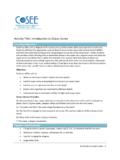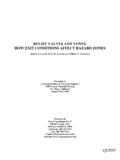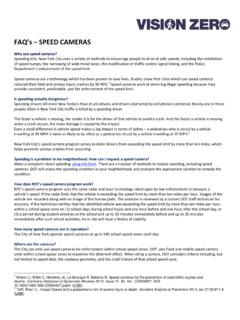Transcription of Safety Zones Around Machinery - slosipe.org
1 Safety Zones Around Machinery Many questions have come up during my training classes about how much distance should a Safety zone be painted or marked Around Machinery . Usually, the rule of thumb is the largest piece of work being made on one machine can not interfere with the largest piece of work being worked on at the same time on an adjacent machine. There should also be 28 walking clearance between the machines when both parts are loaded. Another example would be that the floor be marked in such a way as to prevent another person (other than the operator) from being able to reach the danger zone of the machine while it is operation. The following is a guide to be used Around Machinery . Some of this information was provided by the University of Minnesota.
2 Safety Zones and NON-SKID AREAS Purpose: THE Safety ZONE provides the following: I. A. Outlines a safe, non-congested area in which to work. B. Alerts the student that the machine operator has priority in the area. II. THE NON-SKID AREA A. Provides firm footing for machine operators. III. Safety Zones AND NON-SKID AREAS WILL: A. Increase student awareness for Safety practices. B. Provide a usable work area. C. Increase learning proficiency. D. Promote proper machine use. E. Indicate the proper areas from which to operate a machine. IV. COLORS FOR Safety Zones AND NON-SKID AREAS A. Safety Zones : Paint may be used or tape may be used. Yellow or Yellow & Black stripped is recommended as caution of being caught or struck by an object.
3 Plastic tape in rolls, 2" x 36 yards, is available in yellow, red, and orange. Yellow is again recommended. Regardless of the material selected, yellow is recommended as the best color for zone marking. Refer to American National Institute standards (ANSI ). Aisle markers should be painted or stripped in Black or Black & White stripe. V. RECOMMENDED DIMENSIONS AND LOCATIONS OF Safety Zones AND NON-SKID AREAS. Although there are NO specific OSHA standards for identifying or marking Safety Zones , the following information can be used as a guide. Metal & Woodworking Machines A. Tool Grinders: the optimum size Safety zone for a grinder would be 60 inches wide and 28 inches deep. A non-skid Safety zone area should be placed about 6 inches back from the area directly in front of the machine.
4 A suggested location for the grinder would be next to a wall, at the end of a workbench, at the end of the welding booths, or back to back with a machine of similar type. B. Metal Band Saw (horizontal): The optimum Safety zone for a metal band saw would be a basic rectangle 78" x 84" Around a 20" x 48" saw. An additional zone for the stock being fed into the saw should be 24" side and the length as available in the shop. Steel stock is 16-20 feet long, but a 6 to 8 foot area would be adequate for most saw cuts. Non-skid areas should be placed across the end and both sides of the machine about 6 inches from the base. C. Floor Shear: The optimum Safety zone would be 72" x 36". The saw should be positioned with adequate space for feeding long stock into the shear.
5 Non-skid areas should be placed to give a person operating the machine handle maximum footing. D. Tube Bender, Pyramid Rolls and Iron Worker: the optimum Safety zone should be a circle with a 6-foot radius and include approximately 260 degrees of the circle. A non-skid area of 12" x 84" should be located about 10" from the base of the bender or Ironworker. When bending heavy pipe and metal, a non-skid area should be extended to a circle having a 4 and 5 foot radius. The bender requires a large area when being used; however, the handle can be removed for the remainder of the time. E. Drill Press & Milling Machines: The optimum Safety zone Around the drill press should be approximately 60" wide and 78" deep. The non-skid area should be placed in a 12" x 42" area, about 6" from the base of the drill press.
6 The drill press or milling machine could be located behind another tool, which has a blind side or against a wall. F. Table Saw: The optimum Safety zone size for a table saw would be 144" wide and 288" long. This zone would provide for the cross cutting of a 12-foot board and ripping of a 12-foot board. The non-skid area, 24" x 48" should be located in front of the saw. If a radial arm saw or an electric band saw is used for cross cutting the Safety zone width could be reduced to 4 foot. G. Planer: The optimum Safety zone size for the planer would be 3 feet wide and 12 feet long. The non-skid area should be 18" x 18" on the feed side of the planer and a similar area could be prepared on the tail side. H. Radial Arm Saw: the optimum Safety zone size for the radial arm saw would be 24 feet long (side to side) and 4 feet side.
7 This area would provide for the ripping of a 12-foot board. The non-skid area, 24" x 42", should be located in front of the saw and is of sufficient size to permit the operator firm footing when stepping back for cross-cutting. A saw extension roller unit or workbench should extend both directions from the saw table. I. Jointer: The optimum Safety zone for the jointer would be 24 feet long (side to side) and 42" wide. This provides space for a 12-foot board. The non-skid area should be 18" x 60". The jointer could be positioned on the backside of another tool. J. Belt and Disc Sander: the optimum Safety zone for the belt and disc sander would be 4 feet side by 12 feet long for each side. The non-skid area should be 12" x 42".
8 K. Wood Band Saw: The optimum Safety zone for the band saw would be 4 feet wide by 12 feet long. The non-skid areas should be 18" x 36" and 12" x 24".







